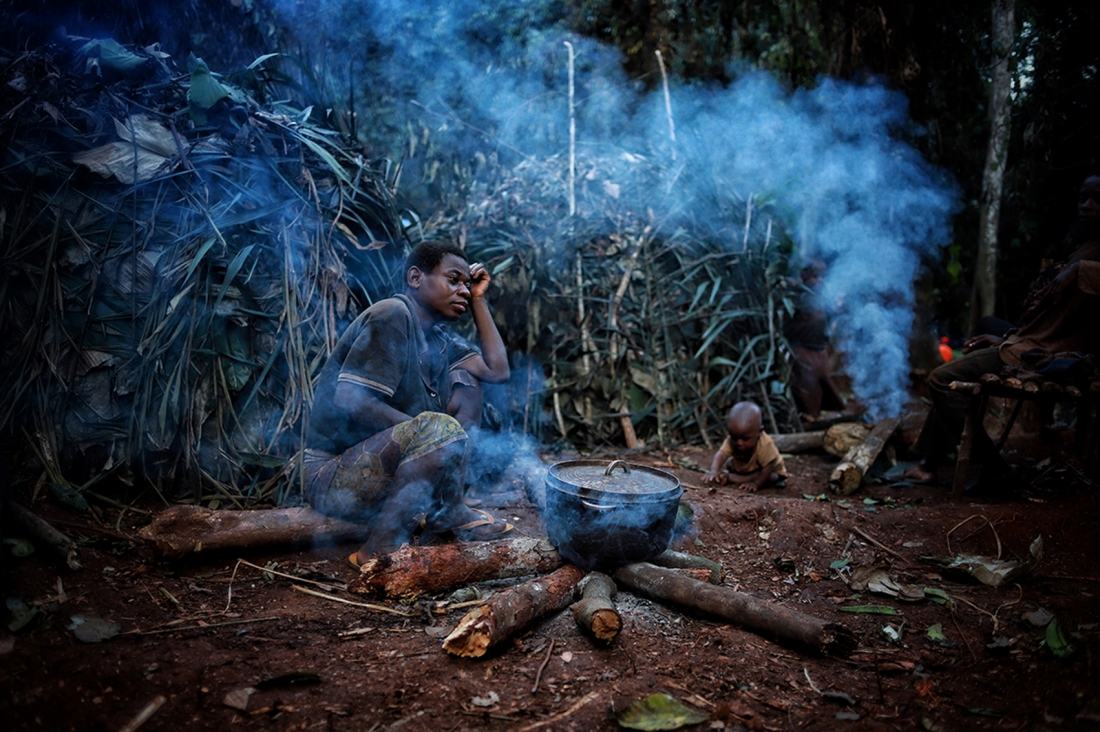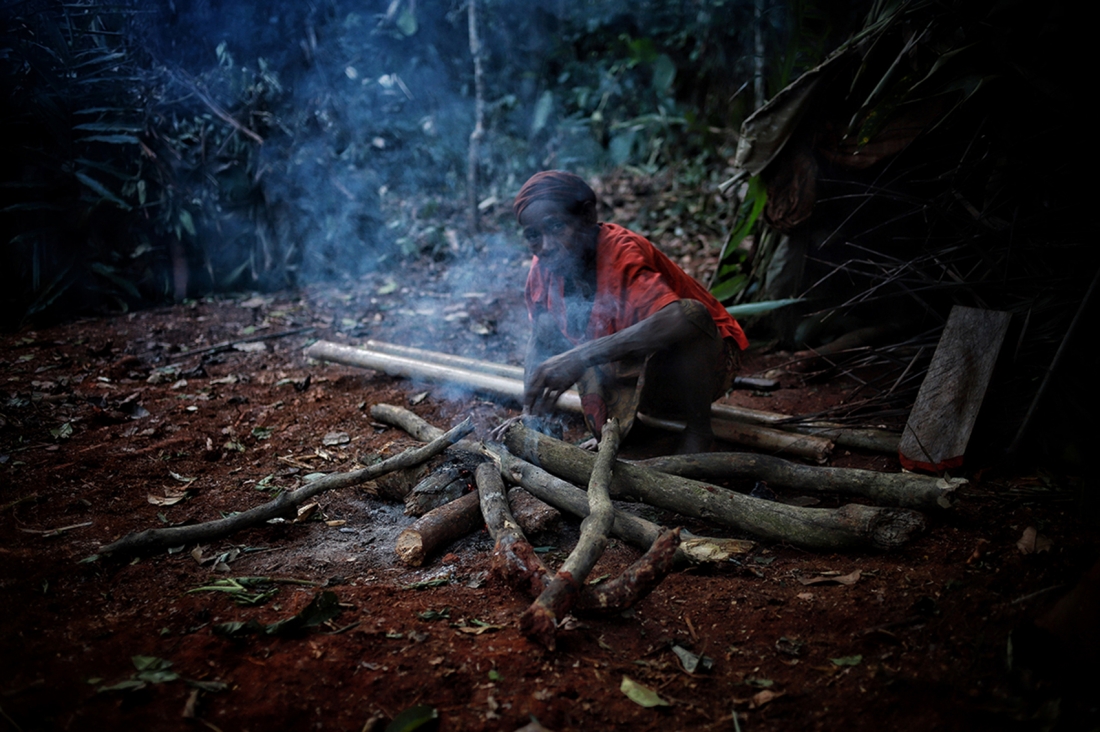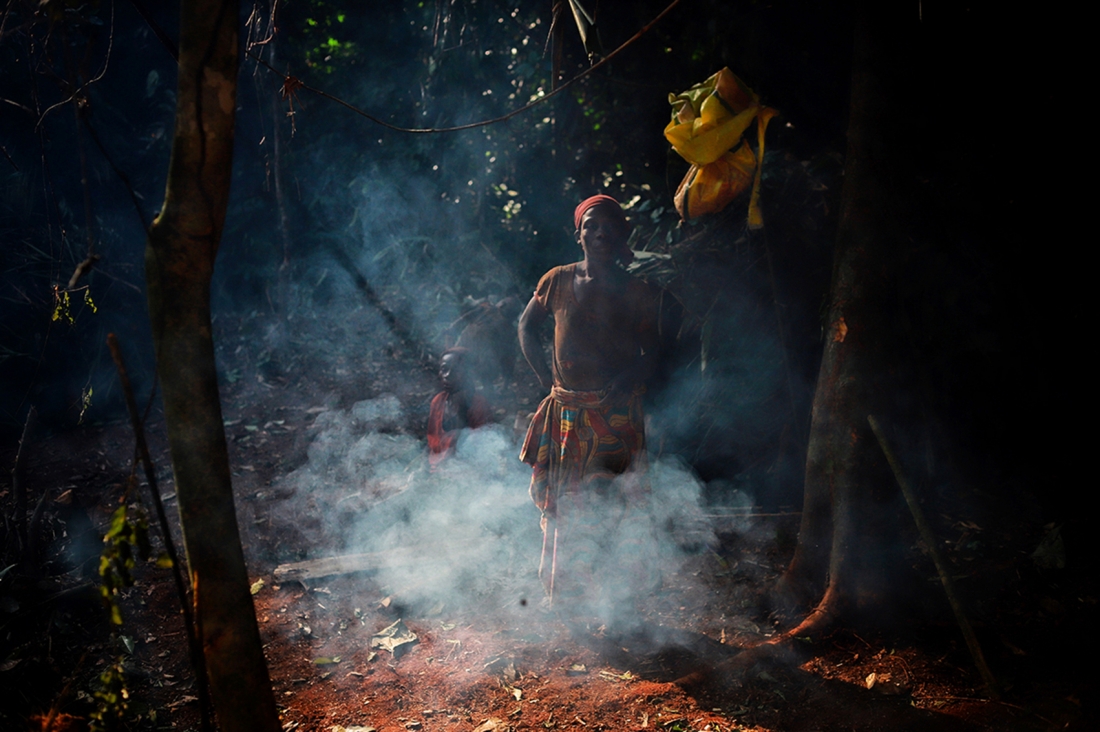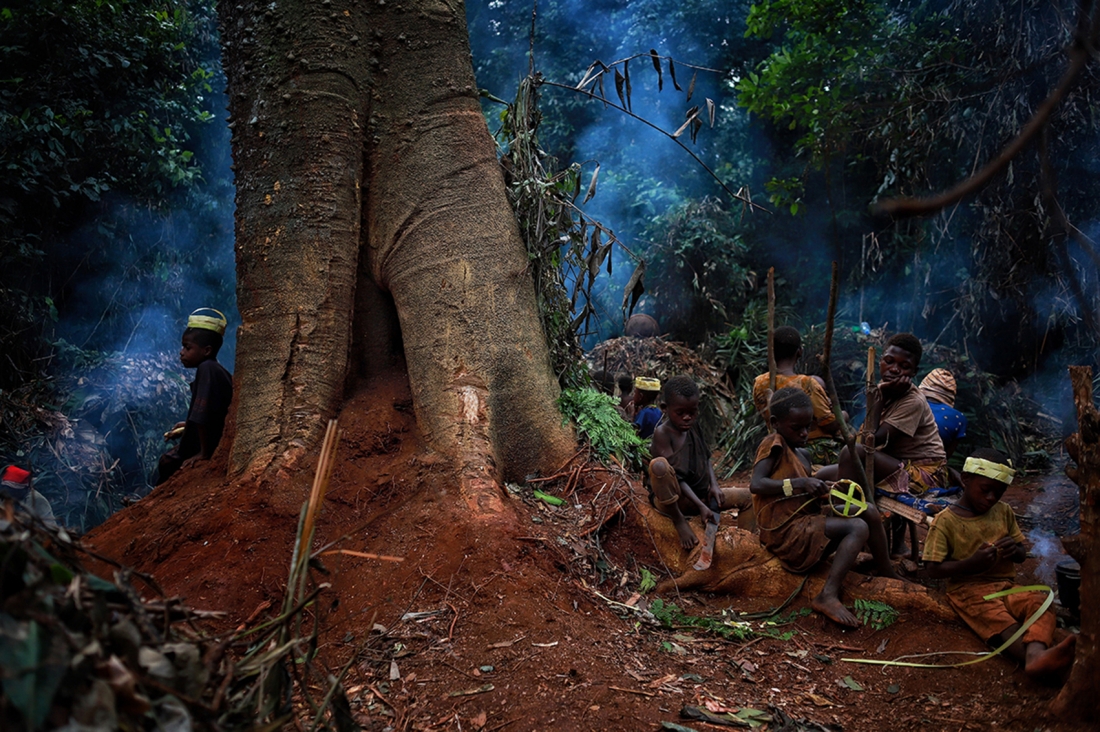We arrived at the Baka Pygmy camp in an hour of broad daylight. Time as time does not exist in that place. It's a new camp from my last stay exactly two years ago, before the pandemic. You are about 500 m away from each other because some trees fell and that unfortunately caused some misfortune.
We arrived after walking a gentle trek for one hour, on this trip the difficulty is much less than others as it is in the dry season. Africa has two seasons, the dry and the rainy. The dry season runs from November to March, but currently climate change is making the weather a bit crazy.
In this case we were lucky that the terrain was of an easy level, without difficulty. When they reached the camp, there were only three or four pygmies. Around 80 pygmies live in this camp, a few years ago they exceeded 100 and more. Little by little as the day passed, they returned to the camp to work in the jungle. Today they are still "slaves" to the Bantus. They work for them for their meals and for the deforestation of the jungle. Outrageous in the 21st century.
Deforestation is doing a lot of damage in the eastern jungle of Cameroon, they are really the colony of the Baka Pygmies who have lived for centuries and centuries in their habitat, in their ecosystem in the middle of nature. They are hunter-gatherers, they live on what they find in the jungle. Currently they are sedentary nomads, they are almost always in the same place. A few decades ago, they traveled throughout the year to find places that would provide the necessary meals for all families.
The growths of animism still continue. Before religions, the human being was animist. Live through nature. The elements of nature: water, air, fire, wood and metal were all they needed to live. Each plant found in the jungle has a remedy and a cure. They are still cured with traditional medicine.
Fire is the essential element in a pygmy camp. Different fires are always lit distributed in different places, both outdoors and indoors. It is one of the most important elements, it is used to cook, to warm up, to have light at night and to scare away mosquitoes. Part of the fires is always lit.
They always look for places near rivers or streams. Water is the most important element for a human being. In the jungle where the pygmies live, carry them regularly, this makes them have water. Sometimes the rains are torrential and they look for places that protect them from their homes. The houses are made with the branches and leaves of the jungle, they are leaves of a large size, there is a side that is dry, the water slides and makes a good protection to be able to live in peace. They live surrounded by trees that rise to more than 40 m in height. This makes the pygmies appear smaller, currently measuring between 1.40 and 1.60m. Before they measure less.
Their clothing has long been made of African fabrics, especially women or "normal" t-shirts and pants. They have not dressed in the traditional clothing of the jungle leaves for decades. If you see any report dressed like this, they are disguised, literally.
When you arrive at the pygmy camp, the first thing to do is approach the head of the colony to welcome you.
During the 12 years that I went for the first time, I am working on this photographic report of how the Baka Pygmies live in everything and the difficulties they have due to deforestation. Every time, it is more difficult for them to live in their habitat,
This is a report to make humanity aware that this ethnic group wants to continue living like their ancestors, in the jungle, in nature.
professional category
BAKA PIGMIES, LIVING IN THE JUNGLE IN THE 21ST CENTURY (Series)
DESCRIPTION
AUTHOR
Fàbregas has been trained as a photographer through the participation in courses given by Foto-Film Calella (2000), and by the Institut d’Estudis Fotogràfics de Catalunya (2001). His training has been complemented in a self-taught way,
through personal research and constant practice in the profession.
His work has been seen through exhibitions and publications in newspapers with the aim of showing the diversity of life forms in different parts of our planet. Being a reporter in the newspapers La Vanguardia and El Punt Diari. And publishing one of his projects in the newspaper Presencia, in which he documents the celebration of
an African wedding.
In his photographic career it is worth mentioning the achievement of more than more than 100 photographic awards, among them the 1st Prize of the Travel Magazine Rutas del Mundo in the Portrait category (2006), and the award of the Silver Medal of the Foto-Film Calella Association (2003). The second prize in the contest of Development and Cooperation of the Generalitat Valenciana (2006), the first prize in the contest Ombú de Pineda de Mar (2007), the third prize in the humanitarian contest Pere Ferran de Sabadell (2007), the first prize in the contest Abeja de Oro de Guadalajara (Madrid 2007) and the first prize in the contest of the magazine Loney Planet (2009).
Highlight the SECOND PRIZE obtained in NEW YORK in November 2009 by the RESOURCE MAGAZINE with a total of 10,000 participants from around the world with the collection SCHOOLS OF MALI and an HONORABLE MENTION obtained in LONDON in the 4th Annual Photography Master Cup competition in
2010.
He has made multiple exhibitions, including Imaginary Portraits I and II; Anantapur, the India of Vicente Ferrer; Guess my country, a report on children from different cultures currently living in Catalonia, and A vision of Gambia, after traveling to the town of Julanguel with the African Association Moussa Molo of Calella. Autistic Children, Souls with Hearts and The House of Life, Illusion and Hope made in Chile
for different organizations.
In 2010 he presents the exhibition 10, a series of 30 images of ten countries that he has traveled during his first decade as a travel and solidarity photographer, the countries are: INDIA, SENEGAL, GAMBIA, MOROCCO, MALI, CHILE, USA,
BOSNIA, ISRAEL AND CAMEROON.
In 2012 he presented his work on Africa in Rosario, Argentina. The work is entitled
A vision of Africa.
His passion for photography, perseverance and perseverance, has led him to discover his way of living life through the images he captures with his camera. An
adventurous and supportive photographer, he has made reports on humanitarian
work in various countries, such as India, Africa, Chile and Argentina.
Since 2009 he has been working on his latest project of responsible and solidarity travels in Africa, different and exciting trips where he takes travelers to discover an authentic Africa, basically visiting rural villages where the traveler discovers the essence and beauty of its people and culture. In one of the trips he discovers the population of Caparan, where he begins to make projects of Health, Education, Sports and Cultural. In 2013 she founded Etnik Solidaria to carry out these projects. In 2015 she set up her own personal project #VIAJESENRUTA. Travels outside agencies and with a personal style, makes routes in Senegal, Gambia, Burkina Faso, Benin, Cameroon, India, Mongolia and opening routes in South
America.
In 2017 he inaugurates the exhibition SentirLas, África sentir las emociones where he tours different countries of Sus America such as Argentina, Chile, Peru and Mexico to show his work and giving lectures about his photography, his travel and humanitarian projects and his way of life. He finishes the tour in his country,
exhibiting and lecturing in Madrid, Barcelona, Menorca and Calella, his hometown.
In 2019 he travels to New York to start a new photographic project LOOK AT THE LOOK, REACH THE SOUL with a team of artists from different parts of the world. It is founded @wecanchangetheworld. During this year he is preparing his new tour that will take him again to exhibit in Argentina, Peru, Mexico, Brazil, Miami or New York, already confirmed. This exhibition is a work of many years of hard work and
dedication.
In 2020 he publishes his book "Learn from nothing, to have it all" book of his 20
years of experiences around the world.
That same year he presents the exhibition "LOOK AT THE LOOK, GET TO THE SOUL" Calella, her hometown, a set of humanitarian photographic works carried out in different parts of the world. In the middle of the pandemic is seen by more
than 100o people.
In 2021 he presents the exhibition BAKA PYGMIES at the Volcano Active Shop
Foundation in Barcelona and this same year her work is presented in Brussels.
The Baka Pygmies report has been awarded in different international photographic
events. It is a job that started 12 years ago.
This year the third prize of the international Official iPhone IppAwards contest in the
category of portraits was to be highlighted during its last stage.The profits from her
photographs help different humanitarian projects in many parts of the world.
through personal research and constant practice in the profession.
His work has been seen through exhibitions and publications in newspapers with the aim of showing the diversity of life forms in different parts of our planet. Being a reporter in the newspapers La Vanguardia and El Punt Diari. And publishing one of his projects in the newspaper Presencia, in which he documents the celebration of
an African wedding.
In his photographic career it is worth mentioning the achievement of more than more than 100 photographic awards, among them the 1st Prize of the Travel Magazine Rutas del Mundo in the Portrait category (2006), and the award of the Silver Medal of the Foto-Film Calella Association (2003). The second prize in the contest of Development and Cooperation of the Generalitat Valenciana (2006), the first prize in the contest Ombú de Pineda de Mar (2007), the third prize in the humanitarian contest Pere Ferran de Sabadell (2007), the first prize in the contest Abeja de Oro de Guadalajara (Madrid 2007) and the first prize in the contest of the magazine Loney Planet (2009).
Highlight the SECOND PRIZE obtained in NEW YORK in November 2009 by the RESOURCE MAGAZINE with a total of 10,000 participants from around the world with the collection SCHOOLS OF MALI and an HONORABLE MENTION obtained in LONDON in the 4th Annual Photography Master Cup competition in
2010.
He has made multiple exhibitions, including Imaginary Portraits I and II; Anantapur, the India of Vicente Ferrer; Guess my country, a report on children from different cultures currently living in Catalonia, and A vision of Gambia, after traveling to the town of Julanguel with the African Association Moussa Molo of Calella. Autistic Children, Souls with Hearts and The House of Life, Illusion and Hope made in Chile
for different organizations.
In 2010 he presents the exhibition 10, a series of 30 images of ten countries that he has traveled during his first decade as a travel and solidarity photographer, the countries are: INDIA, SENEGAL, GAMBIA, MOROCCO, MALI, CHILE, USA,
BOSNIA, ISRAEL AND CAMEROON.
In 2012 he presented his work on Africa in Rosario, Argentina. The work is entitled
A vision of Africa.
His passion for photography, perseverance and perseverance, has led him to discover his way of living life through the images he captures with his camera. An
adventurous and supportive photographer, he has made reports on humanitarian
work in various countries, such as India, Africa, Chile and Argentina.
Since 2009 he has been working on his latest project of responsible and solidarity travels in Africa, different and exciting trips where he takes travelers to discover an authentic Africa, basically visiting rural villages where the traveler discovers the essence and beauty of its people and culture. In one of the trips he discovers the population of Caparan, where he begins to make projects of Health, Education, Sports and Cultural. In 2013 she founded Etnik Solidaria to carry out these projects. In 2015 she set up her own personal project #VIAJESENRUTA. Travels outside agencies and with a personal style, makes routes in Senegal, Gambia, Burkina Faso, Benin, Cameroon, India, Mongolia and opening routes in South
America.
In 2017 he inaugurates the exhibition SentirLas, África sentir las emociones where he tours different countries of Sus America such as Argentina, Chile, Peru and Mexico to show his work and giving lectures about his photography, his travel and humanitarian projects and his way of life. He finishes the tour in his country,
exhibiting and lecturing in Madrid, Barcelona, Menorca and Calella, his hometown.
In 2019 he travels to New York to start a new photographic project LOOK AT THE LOOK, REACH THE SOUL with a team of artists from different parts of the world. It is founded @wecanchangetheworld. During this year he is preparing his new tour that will take him again to exhibit in Argentina, Peru, Mexico, Brazil, Miami or New York, already confirmed. This exhibition is a work of many years of hard work and
dedication.
In 2020 he publishes his book "Learn from nothing, to have it all" book of his 20
years of experiences around the world.
That same year he presents the exhibition "LOOK AT THE LOOK, GET TO THE SOUL" Calella, her hometown, a set of humanitarian photographic works carried out in different parts of the world. In the middle of the pandemic is seen by more
than 100o people.
In 2021 he presents the exhibition BAKA PYGMIES at the Volcano Active Shop
Foundation in Barcelona and this same year her work is presented in Brussels.
The Baka Pygmies report has been awarded in different international photographic
events. It is a job that started 12 years ago.
This year the third prize of the international Official iPhone IppAwards contest in the
category of portraits was to be highlighted during its last stage.The profits from her
photographs help different humanitarian projects in many parts of the world.
back to gallery







